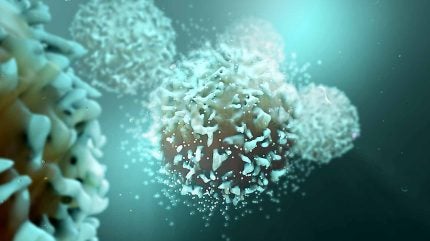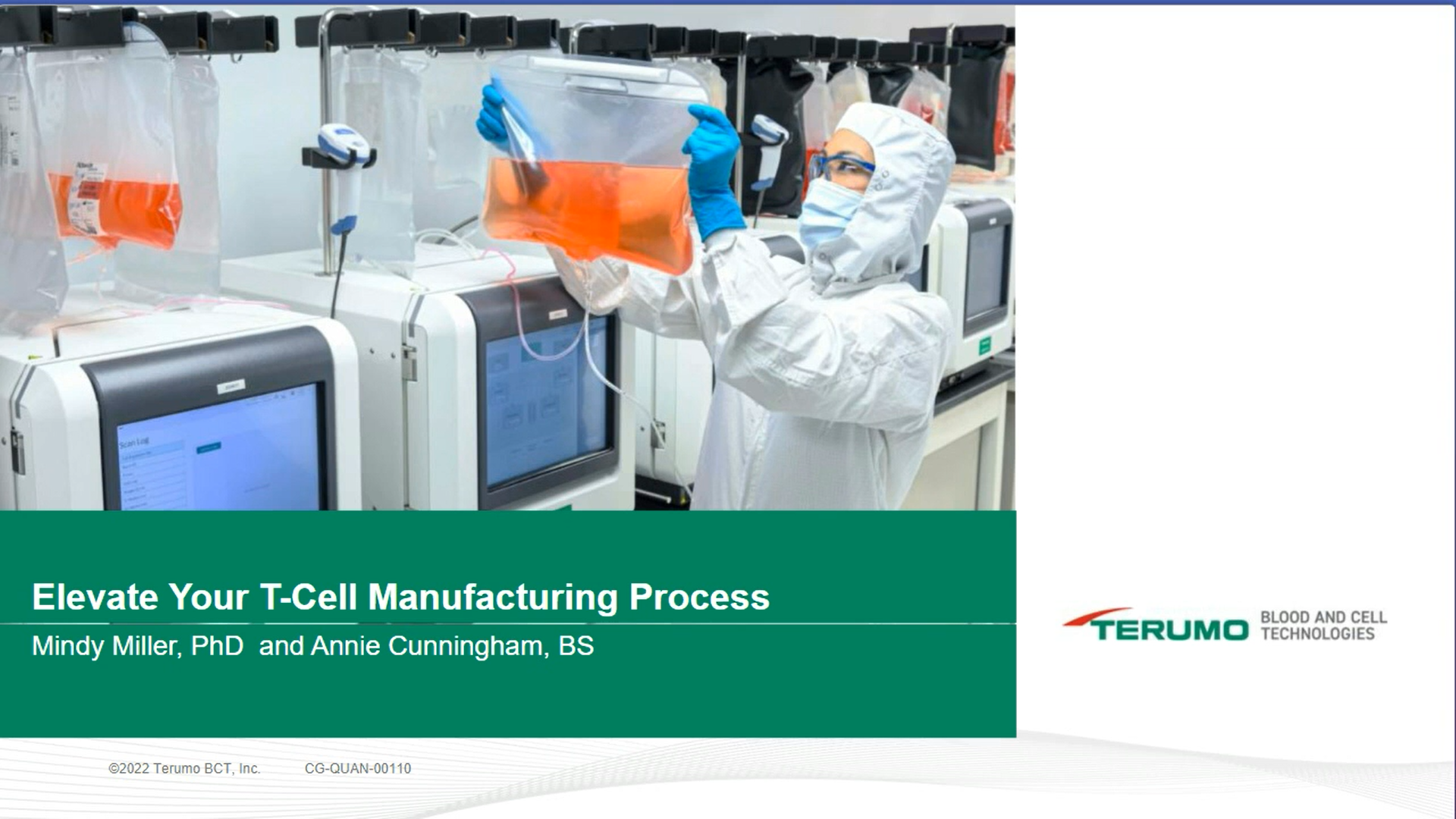
Unlocking the potential of T cells offers hope to a range of patients with serious diseases, such as cancer, and limited treatment options. But manufacturing has typically been expensive and complex.
Historically, manufacturers faced a choice between quality and quantity. A lack of quality T cells meant not enough patients could benefit, while the cells available from large-scale batch manufacturing did not always meet quality or efficacy requirements.
“There is a point at which you have expanded your cells potentially beyond therapeutic efficacy,” says Nathan Frank, senior scientist at Terumo Blood and Cell Technologies. “Just adding more is not going to change the outcome of the therapy. So, dialling your process in such a way that you get the right amount of cells in the right amount of time is part of that. It’s trickier than just going as high as possible.”
However, advances in technology are starting to mean that quality versus quantity is no longer a choice that manufacturers need to make. It is now possible to produce quality T cells at scale. Nevertheless, complexities and challenges remain.
CAR T-cell therapy explained
While the body’s immune system naturally seeks to attack cancer cells, these cells have ways to effectively bypass the immune response to continue multiplying.
Chimeric antigen receptor (CAR) T-cell therapies start with extracting T cells from the patient’s blood and modifying them in a lab to equip them with the capacity to develop receptors that bind to cancers. When reintroduced to the body, CAR T cells actively seek out and attack cancer cells. High quantities of CAR T cells circulate in the body and multiply to further strengthen the immune system’s capacity to eliminate cancer cells.
After cancer cells have been eradicated, CAR T cells stay in the body and go into standby mode — but can reactivate should the cancer return. Even patients with advanced cancers have gone into remission after successful CAR T-cell treatments.1
At present, the majority of CAR T-cell therapies are administered to combat blood cancers. However, clinical research and trials are underway for treatments of solid tumours associated with lung and breast cancers. In the future, this groundbreaking therapy could be administered as a first-line treatment, potentially allowing patients to avoid the need for lengthy doses of chemotherapy or radiotherapy.
Furthering the understanding of T-cell therapies
Understanding of T cells is developing all the time, with new definitions emerging. For instance, stem cell-like memory T cells (TSCMs) have been identified only relatively recently. TSCMs have longer life spans than other types of T cells, with the capacity to self-renew continuously and a greater resilience against apoptosis, or cell death. Therefore, TSCMs could offer enhanced protection for patients at risk of a recurrence of cancer.2
“It’s really challenging because of the donor differences. It’s not like we can take a subset from one donor and that same subset from a different donor and treat them the same way. Because there are just physiological differences that are outside our control,” explains Mindy Miller, managing senior scientist at Terumo Blood and Cell Technologies. “That said, if we could do a massive scale-up of just broad TSCM or central memory T cells, that would be super advantageous. But we have to be precise in knowing the conditions and the expansion time that would allow that to happen.
“That’s almost a donor-to-donor thing within a particular range. Developing a product that would be large-scale and consistent is the trick.”
Developing and manufacturing successful CAR T-cell therapies
For successful treatments, billions of CAR T cells are required. For developers of such treatments, it is vital to explore all options and variables in the early phases, since there is a lack of flexibility once manufacturing is underway.
“When the therapies are in development, you have the freedom to change variables,” says Miller. “That’s the exploratory phase where we can identify what is actually needed for the optimal outcome.
“Hopefully, those are completely solid by the time you go into manufacturing.”
As manufacturers move away from the flask and scale up operations, controls and consistency in processes remain critical. Typically, having more required media exchanges and processing steps increases the potential for negative impacts on the product. Fewer process steps reduce these opportunities.
Notably, automation is unlocking new possibilities in closed systems, which can improve the consistency and quality of T cells produced in large batches. These factors are all contributing to increased patient safety.
“From a science standpoint, it’s fascinating to see the subtypes that are evolving,” says Miller. “We’ve seen huge jumps in automation in fully closed systems, things that can reduce the risk of the process or create stability and consistency between doses.”
Reducing the costs of cell therapies
Cost is a major barrier to increasing the accessibility of T-cell therapies for patients. However, expanding production capacity while maintaining quality can help reduce costs and allow more patients to benefit. As more T-cell therapies come onto the market, this creates crucial opportunities to gather data on the therapies. Findings can then be applied to refine and further enhance the quality and scale of treatments.
“The more we can make these products larger scale and eventually move towards cheaper and [greater] accessibility, not only do we impact more patients — we gather more data,” adds Frank. “That snowballing of data that comes from more and more treatments drives innovations in future treatments and makes those more pointed, direct, and appropriate for better therapy.”
T-cell therapies: A new era of medical treatments
Considerable progress has been made in the last few years in T-cell therapies. Advances look set to only accelerate over the next decade, with scientific understanding advancing in parallel with technologies.
“Science is moving at the same pace as manufacturing. So, we’re developing manufacturing equipment for these cell types as science is illuminating what cell types it is we need,” adds Miller. “So, there’s this concurrent evolution of both manufacturing and science. It’s been really interesting to see how we can create devices for what the market needs at that time point and then pivot those devices to suit what is clinically relevant.”
The future for T-cell therapies is exciting many in the biopharma industry as knowledge and technologies evolve to deliver advances and treat a greater range of conditions, with significant potential in autoimmunity.
“The more we’re learning — like T-cell therapy for autoimmunity, that’s going to be absolutely huge,” adds Miller. “Ten years ago, when I was still a research immunologist, I worked heavily in autoimmunity. It was all about T cells being the bad guys — these are the ones causing your disease. Now we’ve totally flipped that coin to say: ‘No, we can modify those T cells to suddenly cure your autoimmunity [disorder]’.
“We’re really just harnessing the power of your own body to not only kill your cancer but also to kill your rogue T cells.”
To learn how Terumo Blood and Cell Technologies devices enabled increases in T-cell expansion while maintaining memory phenotype, follow the link below.
References
- Melenhorst JJ, et al. Decade-long leukaemia remissions with persistence of CD4+ CAR T cells. Nature. 2022;602(7897):503 509. doi: 10.1038/s41586-021-04390-6.
- Wang Y, Qiu F, Xu Y, et al. Stem cell-like memory T cells: the generation and application. J Leukoc Biol. 2021;110:1209 1223. https://doi.org/10.1002/JLB.5MR0321-145R



